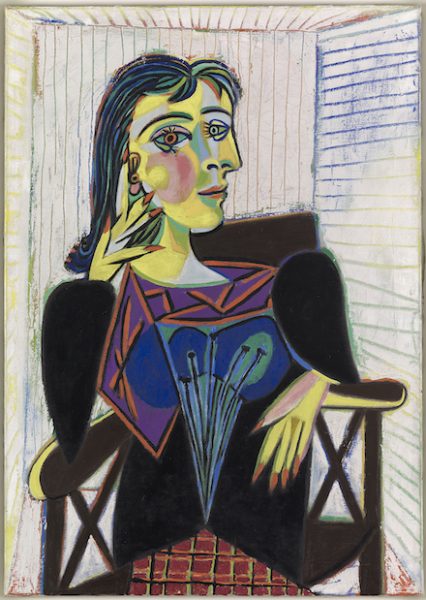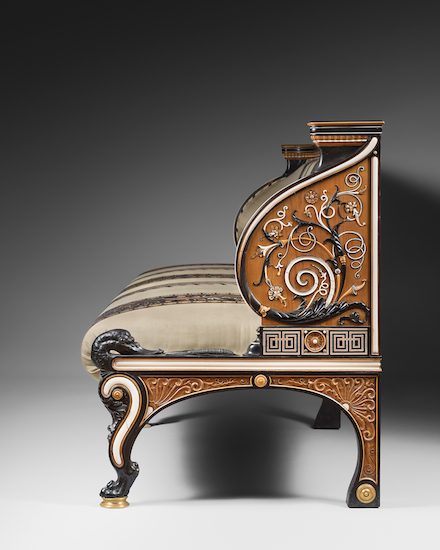
Pablo Picasso (Spanish, 1881–1973), Portrait of Dora Maar, 1937. Oil on canvas, 31 7/8 x 23 5/8i n. MPI58. © 2017 Estate of Pablo Picasso / Artists Rights Society (ARS), New York. Photo: Mathieu Rabeau, Musée Picasso © RMN-Grand Palais / Art Resource, NY
(WILLIAMSTOWN, Mass.) – Works by Pablo Picasso go on view at the Clark Art Institute on Sunday, June 4, along with an exhibition devoted to painter-designer Sir Lawrence Alma-Tadema. Picasso: Encounters includes paintings and prints by the 20th century visionary and is on view through Sunday, August 27. An opening celebration for the exhibits will be held on Saturday, June 3, at 7pm, on the lower level of the Clark Center.
An after-party will be held at 8:30 pm. Tickets are $125 ($100 Clark members) and include admission to the exhibitions, drinks, delicacies inspired by the Gilded Age, live jazz with the Aaron Dean Trio, and admission to the after-party. Tickets to the after-party only are $10 and include dancing with DJ Intell Hayesfield. There will be a cash bar. To reserve tickets for the opening celebration or the after-party, visit Clark Art Institute or call 413 458 0524.
Picasso: Encounters explores Pablo Picasso’s (1881–1973) interest in and experimentation with large-scale printmaking throughout his career, challenging the notion of Picasso as an artist alone with his craft. The exhibition includes important paintings on loan from the Musée national Picasso–Paris. The exhibition addresses his expansive formal vocabulary, the narrative preoccupations that drove his creative process, the often-neglected issue of the collaboration inherent in print production, and the muses that inspired him, including Fernande Olivier, Olga Khokhlova, Dora Maar, Françoise Gilot, and Jacqueline Roque.
The exhibition begins with Picasso’s seminal Self-Portrait (1901) from his Blue Period as a representation of the artist’s mythic isolation. The painting, on loan from the Musée national Picasso–Paris, is followed by 35 of the artist’s most important graphic achievements, ranging from the Clark’s rare impression of The Frugal Repast (1904) — Picasso’s first major statement in printmaking — to Ecce Homo, after Rembrandt (1970), executed three years before his death.
Picasso continuously mined his personal life for subject matter. The exhibition includes the captivating 1923 drypoint portrait of his first wife, Olga, the playful image of his daughter Paloma (1952), and the heartrending aquatint of his embittered second wife, Françoise Gilot (1952).
The exhibition also explores the intertwined narrative threads of the Minotauromachia (1934), The Large Bullfight (1935), and Weeping Woman I (1937). Four Weeping Woman prints are accompanied by Portrait of Dora Maar (1937), the revered oil painting on loan from the Musée national Picasso–Paris. Maar was Picasso’s muse and served as his model for the paintings, drawings, and prints of weeping women produced in the 1930s. Picasso’s final years, during which he transformed the compositions of Old Masters from Rembrandt to Cranach to Manet, are represented by linocuts such as Portrait of a Young Girl, after Cranach the Younger, II (1958) and Luncheon on the Grass, after Manet (1968).
The exhibition will be presented in the Clark Center’s Michael Conforti Pavilion.

Sir Lawrence Alma-Tadema (English, born Netherlands, 1836–1912), designer; Johnstone, Norman & Co., London, manufacturers; Long Settee, 1884–85. Ebony, cedar, boxwood, ivory, mother-of-pearl, abalone, brass, glass and red foil, and modern upholstery. Mugrabi Collection. Image © J. Beylard and V. Luc – Agence Phar, Paris
Orchestrating Elegance: Alma-Tadema and Design
June 4–September 4, 2017
As interest in the painter Sir Lawrence Alma-Tadema (1836–1912) surges, the Clark offers new insight into one of his most successful and distinctive artistic endeavors — the design of a music room in the Greco-Pompeian style for the New York mansion of financier, art collector, and philanthropist Henry Gurdon Marquand (1819–1902). Marquand was one of the founders of the Metropolitan Museum of Art.
Alma-Tadema designed the decoration of a Steinway grand piano (now in the Clark’s collection) along with a matching suite of furniture and textiles for the room. The designs of the artist, the exquisite craftsmanship of the suite, and the taste and discrimination of the patron combined to create one of the most extraordinary rooms of the Gilded Age.
Orchestrating Elegance brings together twelve pieces of the original furniture suite, along with paintings, ceramics, textiles, and sculpture from the room, for the first time since Marquand’s estate was auctioned in 1903. Additional material provides background and context to examine the design and execution of the music room project.
The exhibition examines the room and its objects from a number of perspectives, including how the commission unfolded and why Alma-Tadema was chosen to design the interior; the roles played by various artists involved in the project; the aesthetic impact of the finished furniture and room; and the history of the piano as a musical instrument.
The exhibition will be presented in the Clark Center’s lower level galleries.
“We are looking forward to an exceptional summer and are delighted to be able to bring such important works to Williamstown to share them with our community and our visitors,” said Oliver Meslay, Felda and Dena Hardymon Director of the Clark Art Institute. “Some of these exhibitions originate from the Clark’s permanent collection and some are presented through the generosity of lenders with whom we have close working relationships — and all of them promise to offer new insights into the artists whose works are on view. This will be the first summer season in which our entire campus will be fully open, and we think it will be a spectacular experience for our visitors.”
ABOUT THE CLARK
The Clark Art Institute, located in the Berkshires of western Massachusetts, is one of a small number of institutions globally that is both an art museum and a center for research, critical discussion, and higher education in the visual arts. Opened in 1955, the Clark houses exceptional European and American paintings and sculpture, extensive collections of master prints and drawings, English silver, and early photography. Acting as convener through its Research and Academic Program, the Clark gathers an international community of scholars to participate in a lively program of conferences, colloquia, and workshops on topics of vital importance to the visual arts. The Clark library, consisting of more than 270,000 volumes, is one of the nation’s premier art history libraries. The Clark also houses and co-sponsors the Williams College Graduate Program in the History of Art.
The Clark is located at 225 South Street in Williamstown, Massachusetts. Galleries are open Tuesday through Sunday, 10 am to 5 pm. Admission is $20; free year-round for Clark members, children 18 and younger, and students with valid ID. For more information, visit Clark Art Institute or call 413 458 2303.
